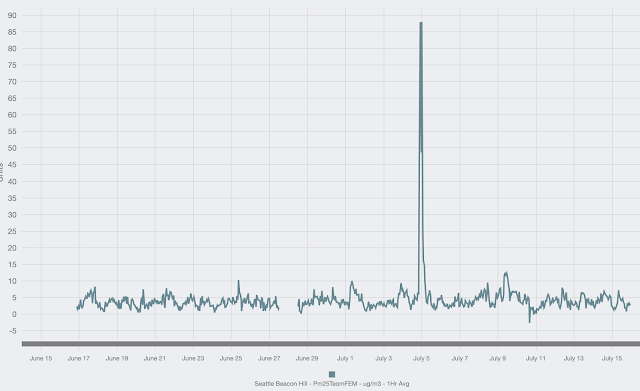2019
2018
These high levels of small particles are quite unhealthful, aggravating ailments such as asthma and heart disease.There are, of course, two sources of the such fireworks pollution: large community displays and personal fireworks. The former typically use large shells propelled by large mortars, injecting more particles higher into the atmosphere. Personal fireworks are more numerous and widespread, but the densest concentrations of pollutants are near the surface.
I have always wondered: what are the relative contributions of the professional/community displays versus personal fireworks in terms of contributions to air pollution and the big spikes in particles (like shown below). It was difficult to secure an answer because both happened at the same time.
But this year, a controlled experiment is going to take place on July 4th: most community fireworks displayed were cancelled, while there are reports of "healthy" sales of personal fireworks. Will there be a similar peak in pollutants? Will air quality decline more because folks will go for big shows to provide distraction from all their current troubles? We will know by next Sunday.







Tulalip's boom city will not allow people to light fireworks at the open area near the fireworks stands because the corona virus will stick to the ash and spread the virus really?
ReplyDeleteNo, it’s basically because people who set off personal fireworks are usually immature, inconsiderate and generally situationally unaware.
DeleteI'll betcha personal fireworks are far and away the biggest pollution contributor and that spike will be very close to normal years. We'll see in a few days!
ReplyDeleteI would think most fireworks displays were canceled because of the crowds that would show up and not practice social distancing and mask wearing. Here in the Methow Valley I am grateful that fire works are completely banned because of the risks of fires. Well they aren't totally banned, Winthrop has a wonderful display of fireworks just after thanksgiving when we usually have snow on the ground.
ReplyDeleteVery curious about results of this experiment. Much more interesting post than the typical annual anti-fireworks rant. Thanks Cliff!
ReplyDeleteI think there might be more street fireworks than normal this year because of the lack of big firework shows and alot of people feeling too isolated and looking for an excuse to celebrate. Could alot of street fireworks produce the same amount of smoke as the normal firework shows?
ReplyDeleteGiven the rain, at least in the northern zone, I expect it's going to be cool and humid on Saturday. As wet as it's been, I'm not particularly worried. Here's to common sense!
ReplyDeleteMy hypothesis is that there will be little difference.
ReplyDeleteMy area has no community shows nearby, yet every years I drive through a haze on my way home from my mom's.
It'll be interesting to see what results can be determined from yesterday.
ReplyDeleteLast night had more arial fireworks, and fireworks in general than I have ever seen in 30 years.
So many, we were driven indoors from the noise!!
First time ever.
That was horrible. My apartment filled with firework-smog. I got the worst migraine and got tmi type of sick (which is unusual for me). The beautiful displays at the lake were sending huge plume southward right at building height. I have some immune issues and am sensitive to toxins.
ReplyDeleteInterested to know the outcome of this. Down here in Portland it sounded like we were in the middle of a raging war zone for at least 4 hours (just after 9pm until almost 2am). The roar of Chinese manufactured thunder was relentless! Though I didn't really notice much in the way of smoke, we did have a nice little breeze, which I'm sure helped clear it out quickly.
ReplyDeleteHow about the followup graph, Cliff?
ReplyDeleteHi can we use HEPA Filter Air Purifiers to clean the air pollution in surrounding whichh is caused by the fire works?
ReplyDelete